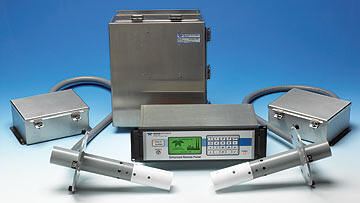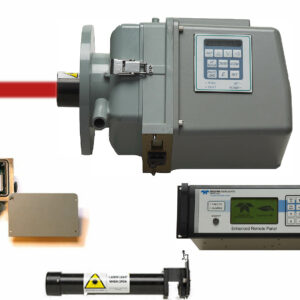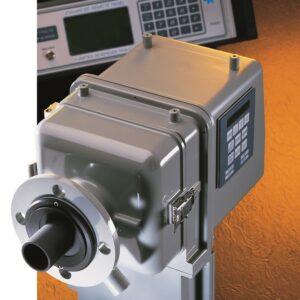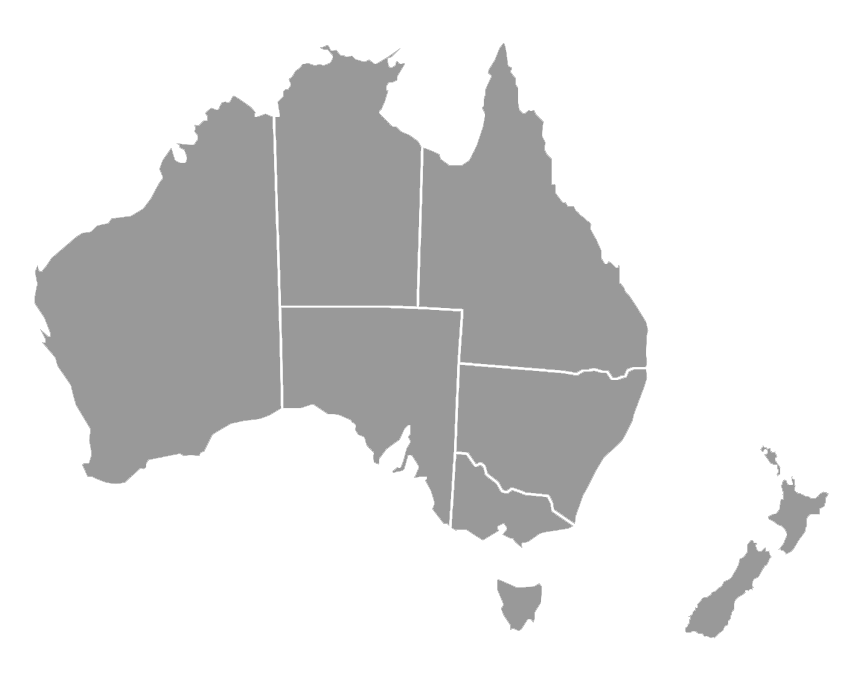The Ultraflow Model 150 is a non-contacting gas flow and temperature monitor for CEMS and Stack Air Monitoring. The system measures the transit time of a tone burst through the gas stream to determine both flow and temperature. Transducer assemblies are usually mounted opposite each other at an angle on each side of the stack or duct with one transducer upstream from the other. In locations where a second access platform is cost prohibitive, a shallower angle, resulting in upstream/downstream transducer offsets as small as 4 feet may be used. If the reduced transducer offset results in pitch-angle errors, a dual set of transducer assemblies (four) can be installed. This “X” Pattern provides an average flow measurement directly up the stack and has the potential added benefit of multiple certifications of both transducer assembly sets. This ensures nearly 100% uptime.
Ultraflow 150 Flow Monitor Brochure
The system accurately measures the time required for the tone bursts to traverse the gas stream in each direction. The flow velocity is directly related to the difference in propagation time, t1 and t2 of the tone bursts with and against the gas flow. Based on the cross-sectional area of the stack or duct, the flow velocity is converted to volumetric flow. This flow measurement is independent of the temperature, density, viscosity and particulate or condensate concentration.
Innovative, non-contacting technique greatly reduces maintenance
The Ultraflow 150 represents an advance in continuous flow measurement systems for small and large stacks and ducts. Transducers are non-intrusively mounted in Teflon housing and are protected from flue gas and particulate with continuous purge air. This non-contacting method mitigates maintenance and ensures long term operation unlike intrusive pitot, thermal systems, optical scintillation and reflective ultrasonic technology.
Velocity measurement independent of temperature, pressure and density of flue gas
The system measures the transit times, t1 and t2, of the tone bursts between the pair of transducers with a 50 nanosecond transit time resolution. The equation for determining velocity is:
Fv = [L/(2cosØ)][(t2-t1)/t2t1]
Where L is the pathlength and Ø is the angle between the line-of-sight of the transducers and the nominal flow direction. The flue gas composition has no influence on the calculation of velocity and therefore knowing only the geometry and transit times are sufficient to calculate the velocity.
Line average response is exceptionally accurate…long term drift ±1%
The Ultraflow 150 integrates the infinitesimal velocity vectors along the transducer path to calculate velocity as well as temperature. A normal sampling cycle consists of many measurements in each direction over a time period that can be as short as 5 seconds. Resolution is better than ±0.3ft/sec. Long term drift is ±1% over the life of the instrument. A barometric pressure transducer option is available to correct back to SCFM.
Temperature Measurements
The equations for determining temperature are:
Cs = (L/2)[(t2+t1)/t2t1]
T = r Cs2
Where Cs is the speed of sound and “r” is a correction factor that relates the speed of sound to a specific gas composition.
Dynamic calibration checks verify all system components
Ultraflow 150 meets all 40CFR75 requirements, NOX ozone season rules and new RATA standards. Calibration checks are conducted once per day or on command to fully test the signal transmission, reception, processing display and output; i.e., a full system integrity test not available via competing technologies. The flow characterization curve is also tested under this protocol. No adjustments are ever made to the zero and span since the monitor is drift free. Calibrations can be initiated manually, automatically, by a digital input or via the front panel command.
Digital signal processing provides greater accuracy, quicker response time and excellent resolution
Ultraflow 150 utilizes a Field Programmable Gate Array (FPGA) to determine the time of flight based on a proprietary peak finding algorithm. Our peak finding algorithm enables response times of down to 5 seconds; making the 150 ideal for hazardous waste combustors and process applications.
Easy to use Enhanced Remote Panel
The remote display features easy-to-use menu structures that make configuration of the flow monitor simple and easy without the need of a laptop. I/O includes four analog outputs, eight digital inputs, eight contact outputs, RS232, 422, 485, and LONWORKS® network communication. A large LCD display makes viewing easy throughout a control room.
Heavy duty components are easy to install
The Ultraflow 150 has simplified placement requirements, using customer-installed, 3½” I.D., schedule 40 pipe as mounting ports. (For other pipe sizes, consult factory). Teledyne Monitor Labs provides all system components. Materials of construction for the Transducer Interface Enclosure and j-boxes are stainless steel. Transducer assemblies are aluminum protected by acid resistant epoxy paint.
“X” Pattern configuration eliminates a second platform
In many cases, due to the 150’s improved resolution, low angles of installation (typ. 5ft. vertical offsets from a single platform) are possible. In some demanding applications, an “X”- pattern may be required.
The Ultraflow 150 has the capability of measuring flow through either a single or dual set of transducers. A dual set of transducers is typically referred to as an “X” Pattern. An “X” Pattern eliminates any adverse effects due to applications that exhibit a pitch flow; enables nearly 100% availability and may institute redundancy.
Transducer Interface Enclosure (TIE)
Electrical signals corresponding to acoustic transmit and receive signals are conveyed via cables between the transducers and the TIE. The TIE houses preamp /driver boards that amplify receive signals and transmit pulses. A signal processing board containing an FPGA controls timing, data collection, filtering, boxcar integration and other functions. A microprocessor board evaluates the box car data and determines time of flight, flow velocity, volume, speed of sound, temperature and signal to noise ratio. All these data values may be viewed via the Enhanced Remote Panel or the optional Local User Interface (LUI).
Purge Air System
The transducer assemblies are normally kept dry and clean by purge air. Depending on the application, the optimal installation may consist of dual blowers (a separate purge blower for each side of the stack), a single blower configuration with flow splitter to reliably send equal amounts of purge air to each side of the stack, or no blowers at all where a reliable negative-draft process is present. A no blower system has an in-line filter to clean up the ambient air. When blowers are used, the normal purge system consists of blowers, hoses, air filters, mounting plates and a protective weather cover. Teledyne Monitor Labs Engineering will recommend the optimum configuration for each application.
Transducer Assemblies
Each of the two transducers alternately acts as transmitter and receiver. The purge nozzles are constructed of acid-resistant Teflon with stainless steel or Hastelloy hardware for easy cleaning and a long service life. Each transducer assembly is made of lightweight aluminum stock and can be easily extracted from its mounting port by disengaging four draw latches.
Enhanced Remote Panel
Uses a large, back-lit, LCD graphics display with English-language menu-driven screens, providing ready access to all information needed for full use of the system. In addition, the user can graph up to the most recent 100 values of a selected parameter, such as:
- Volumetric Flow and Temperature
- Calibration Values
The keypad, a rugged 20-button ensemble inlaid under a tough, hard coated, scratch and chemical-resistant coating, can be used to:
- Display Volumetric Flow, Velocity and Temperature
- Identify the Cause of Alarm or Malfunction
- Configure the Analog Outputs
- Edit Parameters such as Path Length
- Set Alarm Values for High or Low Volumetric Flow or Temperature and Out of Cal measurements
- View Signal-to-Noise Diagnostics
- Load Linearization Curves for Correlation to EPA Method 2
- View Flow Data Pre and Post Linearization
Standard with the Enhanced Remote Panel is a security keylock for protection of important calibration parameters. System elements communicate over a single twisted pair using LONWORKS® network communication protocol. Bright LED indicator lights are used to indicate faults and alarms. The four optically-isolated analog outputs, normally packaged within the Enhanced Remote Panel, can also be offered in a separate housing for convenient installation.
Ethernet Interface
The Ultraflow 150 Enhanced Remote Panel now features a 10/100 BaseT Ethernet interface as standard equipment. This capability provides a multilevel password protected user interface to TCP/IP networks such as LAN’s or the Internet. Client side user interface access is via standard web browsers. Simultaneous Modbus TCP access to instrument parameters and emission data is also supported.






